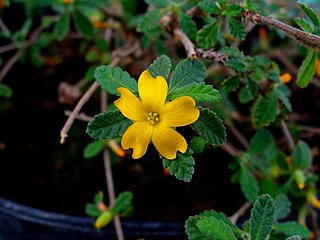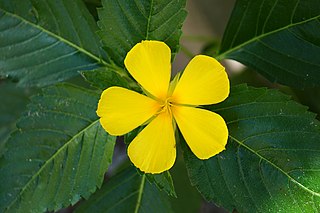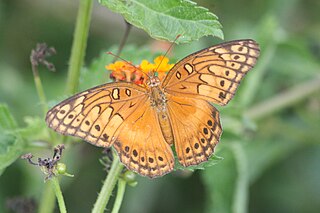
Turnera diffusa, known as damiana, is a shrub native to southern Texas in the United States, Central America, Mexico, South America, and the Caribbean. It belongs to the family Passifloraceae.

Turneraceae Kunth ex DC. is a family of flowering plants consisting of 120 species in 10 genera. The Cronquist system placed the Turneracids in the order Violales, but it is not currently recognized as a family by the Angiosperm Phylogeny Group in the APG III system of 2009, which includes the taxa in the Turneraceae in the Passifloraceae.

Aromatase inhibitors (AIs) are a class of drugs used in the treatment of breast cancer in postmenopausal women and gynecomastia in men. They may also be used off-label to reduce estrogen conversion when using external testosterone. They may also be used for chemoprevention in high risk women.

Pinocembrin is a flavanone, a type of flavonoid. It is an antioxidant found in damiana, honey, fingerroot, and propolis.
Turnera hindsiana is a species of plant in the family Passifloraceae. It is endemic to Ecuador. Its natural habitat is subtropical or tropical moist lowland forests.

Turnera is a genus of flowering plants in the passionflower family, Passifloraceae. It contains more than 100 species native to tropical and subtropical America. The name honours English naturalist William Turner (1508-1568). It was previously placed in the family Turneraceae.

1186 Turnera, provisional designation 1929 PL, is a stony Eoan asteroid from the outer regions of the asteroid belt, approximately 36 kilometers in diameter. It was discovered on 1 August 1929, by South African astronomer Cyril Jackson at the Union Observatory in Johannesburg. The asteroid was later named after British astronomer Herbert Hall Turner.

Turnera ulmifolia, the ramgoat dashalong or yellow alder, is a species of plant of family Passifloraceae, native to Mexico and the West Indies. A recent study found that yellow alder potentiated the antibiotic activity against methicillin-resistant Staphylococcus aureus (MRSA).
Turnera hermannioides is plant species found in Brazil.

Euptoieta hegesia, the Mexican fritillary, is a North and South American butterfly in the family Nymphalidae.

Josia megaera is a moth of the family Notodontidae. It is found from Brazil to Venezuela.

Acacetin is a 4'-O-methylated flavone of the parent compound Apigenin, found in Robinia pseudoacacia, Turnera diffusa (damiana), shows moderate aromatase inhibition, Betula pendula, and in the fern Asplenium normale.
Acraea brainei, the Braine's acraea, is a butterfly in the family Nymphalidae. It is found in north-western Namibia. The habitat consists of granite outcrops on hills and ridges.

Turnera subulata is a species of flowering plant in the passionflower family known by the common names white buttercup, sulphur alder, politician's flower, dark-eyed turnera, and white alder. Despite its names, it is not related to the buttercups or the alders. It is native to Central and South America, from Panama south to Brazil. It is well known in many other places as an introduced species, such as Malaysia, Indonesia, several other Pacific Islands, the Caribbean, and Florida in the United States. It is commonly cultivated as a garden flower.

Ministrymon azia, the gray ministreak, is a butterfly in the family Lycaenidae. It is found from the southern United States to southern Brazil, Paraguay and Argentina. It is found in virtually all lowland habitats, ranging from deserts in coastal Peru and Chile to rainforests in the Amazon basin.

Turnera oculata is an evergreen, woody shrub, bearing striking yellow flowers with a dark centre, and occurring in the Kaokoveld in the Namib Desert in northern Namibia and in southern Angola. It is one of some 130 species occurring mainly in South America, but with two species found in Africa - one in Namibia and Angola, and the other in tropical Africa.

Turnera chamaedrifolia is a species of Turnera in Bahia and Mina Gerias, Brazil.

Turnera opifera is a species of Turnera from Minas Gerais, Brazil.

Turnera scabra is a species of Turnera from Central to South America.

Turnera panamensis is a species of flowering plant in the passionflower family. It is native to Central America and Northwestern Colombia.
















